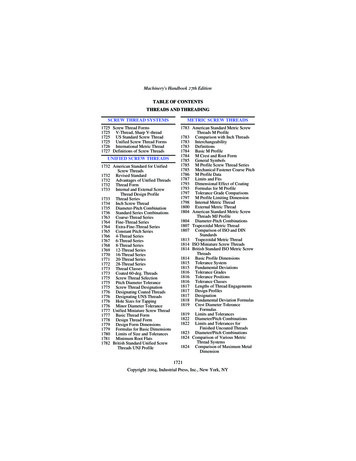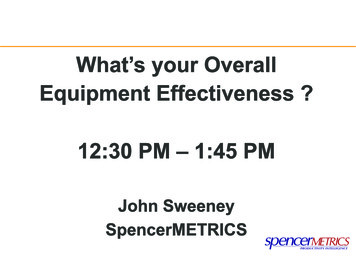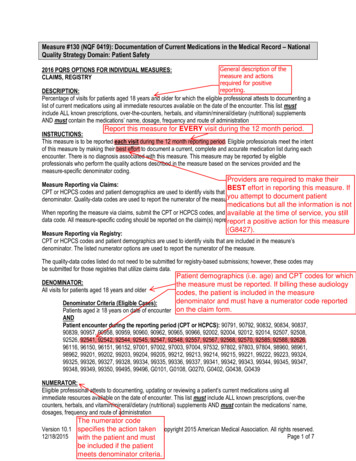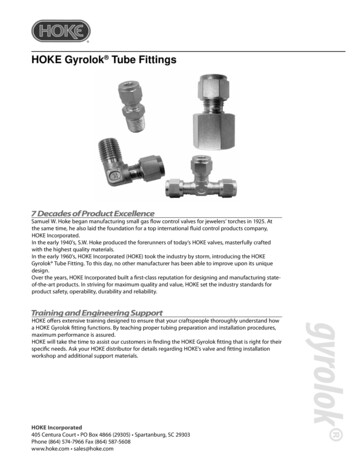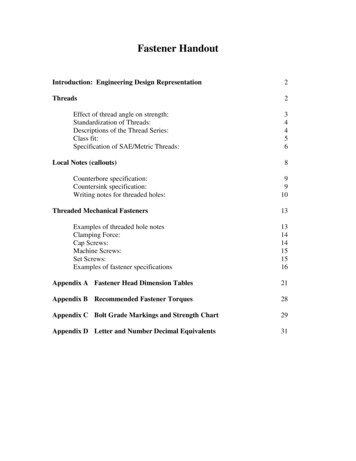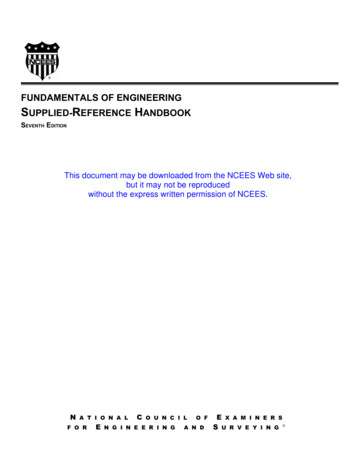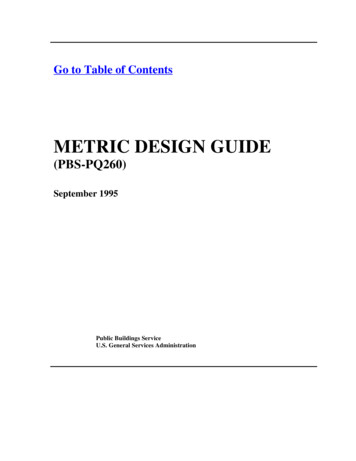
Transcription
Sobolev Spaces on Metric Measure SpacesAn Approach based on Upper GradientsJuha HeinonenPekka KoskelaNageswari ShanmugalingamJeremy T. Tyson
ContentsPrefacepage viii1Introduction12Review of Basic Functional Analysis2.1Normed and seminormed spaces2.2Linear operators and dual spaces2.3Convergence theorems2.4Reflexive spaces2.5Notes to Chapter 23Lebesgue theory3.1Measurability for Banach space-valued functions3.2Integrable functions and spaces Lp (X : V )3.3Metric measure spaces3.4Differentiation3.5Maximal functions3.6Notes to Chapter 33839455276941004Lipschitz functions and embeddings4.1Lipschitz functions, extensions, and embeddings4.2Lower semicontinuous functions4.3Hausdorff measures4.4Functions of bounded variation4.5Notes to Chapter 6integrals and modulusCurves in metric spacesModulus of a curve familyEstimates for modulusNotes to Chapter 5iii8915182637
ivContents6Upper gradients6.1Classical first order Sobolev spaces6.2Upper gradients6.3Maps with p-integrable upper gradients6.4Notes to Chapter 61481491571621727Sobolev spaces7.1Vector-valued Sobolev functions on metric spaces7.2The Sobolev p-capacity7.3N 1,p (X : V ) is a Banach space7.4The space HN1,p (X : V ) and quasicontinuity7.5Main equivalence classes and the MECp -property7.6Notes to Chapter 71741751921982062092128Poincaré inequalities8.1Poincaré inequality and pointwise inequalities8.2Density of Lipschitz functions8.3Quasiconvexity and Poincaré inequality8.4Continuous upper gradients and Lipschitz constants8.5Notes to Chapter 82142152382442492549Consequences of Poincaré inequalities9.1Sobolev–Poincaré inequalities9.2Lebesgue points of Sobolev functions9.3Measurability of equivalence classes and MECp9.4Annular quasiconvexity9.5Notes to Chapter 925525627228229029410Other definitions of Sobolev type spaces10.1 The Cheeger–Sobolev space10.2 The Hajlasz–Sobolev space10.3 Sobolev spaces defined via Poincaré inequalities10.4 The Korevaar–Schoen–Sobolev space10.5 Summary10.6 Notes to Chapter 1029729829930330731631711Gromov–Hausdorff convergence11.1 The Gromov–Hausdorff distance11.2 Gromov’s compactness theorem11.3 Pointed Gromov–Hausdorff convergence11.4 Pointed measured Gromov–Hausdorff convergence11.5 Persistence of doubling measures11.6 Persistence of Poincaré inequalities318319325328337341344
Contents11.7Notes to Chapter 11v34912Self-improvement of Poincaré inequalities12.1 Geometric properties of geodesic doubling spaces12.2 Preliminary local arguments12.3 Self-improvement of the Poincaré inequality12.4 Notes to Chapter 1235135235437037713Cheeger’s differentiation theory13.1 Asymptotic generalized linearity13.2 Caccioppoli type estimates13.3 Minimal weak upper gradients of distance functions13.4 The differential structure13.5 ρu , Lip u, Taylor’s theorem, and reflexivity13.6 Notes to Chapter 1337837938338638839140014Examples and applications14.1 Quasiconformal and quasisymmetric mappings14.2 Spaces supporting a Poincaré inequality14.3 Applications and further research directionsBibliographyIndex of NotationIndex of Terminology402403408424429445447
In memory of Frederick W. Gehring(1925–2012)
PrefaceThe aim of this book is to present a coherent and essentially self-containedtreatment of the theory of first-order Sobolev spaces on metric measurespaces, based on the notion of upper gradients.The project of writing this book was initiated by Juha Heinonen in2000. His premature passing in 2007 significantly delayed the progressin its preparation. We wish to thank Karen E. Smith for securing for usvaluable private material of his pertaining to this text.Over the years of preparation of the manuscript, we have benefitted from discussions with, and advice from, many colleagues. Amongstthem, we wish to give special thanks to the following individuals. Wethank Luigi Ambrosio, Piotr Hajlasz, Ilkka Holopainen, Riikka Korte,Jan Malý, Anton Petrunin, and Stephen Semmes for valuable contributions to the mathematical content of this book. Bruce Hanson and PietroPoggi-Corradini provided detailed comments and corrections of variousdrafts of the manuscript. We also acknowledge Sita Benedict, AndersBjörn, Jana Björn, Estibalitz Durand Cartagena, Nicola Gigli, ChangyuGuo, Nijjwal Karak, Aapo Kauranen, Panu Lahti, Marcos Lopez, MarieSnipes, and Thomas Zürcher for reading the manuscript and providinguseful feedback. The Mathematica code used to create Figures 14.3 and14.4 was written by Anton Lukyanenko.The authors gratefully thank Karen E. Smith and Kai Rajala for theirencouragement in completing this project.Our contributions to the field of research summarized in this bookhave been supported by grants from the U. S. National Science Foundation, the Simons Foundation, and the Academy of Finland. We wishto acknowledge these agencies for their support over the years. We alsowould like to thank the Institute for Pure and Applied Mathematics andthe University of Jyväskylä for their kind hospitality during some of theviii
Prefaceixintensive writing periods. Final editing of the manuscript was completedduring a snowy weekend in January 2014 at the Clifton Gaslight Bedand Breakfast in Cincinnati, Ohio. We wish to thank Scott and MariaCrawford for their hospitality.J. H. (Ann Arbor, deceased)P. K. (Jyväskylä)N. S. (Cincinnati)J. T. T. (Urbana)January 2014
1Introduction1
2IntroductionAnalysis in metric spaces, in the sense that we are considering in thisbook, emerged as an independent research field in the late 1990s. Itsorigins lie in the search for an abstract context suitable to recover a substantial component of the classical Euclidean geometric function theoryassociated to quasiconformal and quasisymmetric mappings. Such a context, identified in the paper [125], consists of doubling metric measurespaces supporting a Poincaré inequality.Over the past fifteen years the subject of analysis in metric spaces hasexpanded dramatically. A significant part of that development has beena detailed study of abstract first-order Sobolev spaces and their relationto variational problems and PDE as well as their role as a tool in, e.g.,function theory, dynamics and related fields. The subject has by nowadvanced to the point that a careful treatment from first principles, intextbook form, appears to be needed. This book is intended to servethat purpose.The concept of an upper gradient plays a critical role in both the notionof Sobolev space considered in this book and the concomitant frameworkof metric measure spaces supporting a Poincaré inequality. This concept,also proposed originally in [125], provides an effective replacement forthe gradient, or more precisely, of the norm of the gradient of a smoothfunction. A nonnegative Borel function g (possibly taking on the value ) on a metric space (X, d) is said to be an upper gradient of a realvalued function u if the inequalityZ u(x) u(y) g ds(1.1)γis satisfied for all rectifiable curves γ joining x to y in X. Here the integralof g on the right hand side of (1.1) is computed with respect to the arclength measure along γ induced by the metric d. We review the theoryof path integrals along rectifiable curves in metric spaces in Chapter 5;Chapter 6 is devoted to the basic properties of upper gradients in metricspaces. It is worth emphasizing that no smoothness assumption on u isa priori imposed in the definition. (Indeed, it is not clear in the metricspace setting what such an assumption would entail.) However, as wewill see in this book, the existence of a well-behaved upper gradient fora function u necessarily implies certain regularity properties for u itself.With the notion of upper gradient in hand it is natural to inquireabout the existence of a theory of Sobolev spaces based on such gradients. The classical Sobolev space W 1,p (Ω), when Ω is a domain in Rn ,can be adapted to the setting of a metric measure space (X, d, µ) by in-
Introduction3troducing the space of p-integrable functions which admit a p-integrableupper gradient. The foundations for such a theory were laid in the thesis [247] and the accompanying paper [248]. In the literature this spaceis often referred to as the Newtonian space and denoted N 1,p (X). Thisterminology highlights the essential role played by the upper gradientinequality (1.1), which in turn serves as an abstract counterpart of theFundamental Theorem of Calculus.Chapters 7, 8, and 9 form the heart of this book. In these chapters weintroduce and give a detailed study of the Sobolev space N 1,p . Amongother results in these chapters, we show that N 1,p is a Banach function space, we study the pointwise properties of Sobolev functions (bothscalar- and vector-valued), and we discuss the density of Lipschitz functions in the Sobolev space.In this book we consistently employ the terminology Sobolev space,although we retain the notation N 1,p (X) both in homage to the originsof the concept and to distinguish this space from other abstract versionsof the classical Sobolev space. In Chapter 10 we review several alternateapproaches to abstract Sobolev spaces on metric measure spaces. Undersuitable assumptions, some or all of these spaces coincide, either as setsor (up to linear isomorphism, or even up to isometry) as Banach spaces.One version of the classical Poincaré inequality on the Euclidean spaceRn states that1 B Z1 u uB Cr B BZ u .(1.2)BHere u denotes a C functionon Rn and B denotes a ball of radius r.R 1The notation uB B u denotes the mean value of u on B. TheBconstant C depends only on the dimension n, i.e., it is independent ofB and u.Using the notion of upper gradient one can reformulate the Poincaréinequality (1.2) in the metric measure space context, by replacing u by any fixed upper gradient g of a given function u. Actually the storyis more subtle. It trivially follows from Hölder’s inequality that (1.2)implies the corresponding inequality where the integral on the right handside is replaced by the Lp norm of u with respect to the Lebesguemeasure on B (normalized by the volume of B as in (1.2)). Moreover,one can replace the ball B by any larger concentric ball λB (λ 1),at the cost of possibly changing the constant C. We say that a metricmeasure space (X, d, µ) supports a weak p-Poincaré inequality if there
4Introductionexist constants C 0 and λ 1 so that the inequality1µ(B) Z u uB dµ CrB1µ(λB)Zpg dµ 1/p(1.3)λBholds for all balls B in X and all function-upper gradient pairs (u, g).As before r denotes the radius of B, while λB denotes the ball with thesame center as B and with radius λr.The importance of the abstract Poincaré inequality (1.3) lies in thefact that it imposes an additional relation between functions and theirupper gradients, at the level of the volume measure µ rather than at thelevel of the length measure along curves. The length-volume principle(usually known as the length-area principle) lies at the core of classicalEuclidean geometric function theory. In our setting the interplay betweenthe upper gradient inequality (1.1) and the Poincaré inequality (1.3) isa principal driving force. When coupled with the doubling condition forthe measure µ (namely, the assumption that µ(2B) Cµ(B) for allballs B in X, where the constant C is independent of B), the Poincaréinequality becomes a powerful tool with both analytic and geometricconsequences.The reader may wonder why we complicate the story by distinguishingthe Poincaré inequality according to the value of the exponent p, as wellas by allowing for the dilated balls λB in the definition. In the Euclideanspace, as already observed, the Poincaré inequality holds with p 1 andλ 1 (and this is the strongest form of the inequality). In the abstractsetting, it is not necessarily the case that a space supporting a Poincaréinequality for some 1 p and with some dilation constant λ 1,necessarily supports a Poincaré inequality for better choices of this data.Under rather mild conditions the dilation parameter λ can always bechosen to be 1. We discuss this and other self-improvement phenomenarelated to Sobolev–Poincaré inequalities in Chapter 9.It is a much deeper fact of the theory that, if the underlying metricspace is complete and the measure µ is doubling, then the exponentp on the right hand side of (1.3) can be improved. In other words, ifsuch a space (X, d, µ) supports a p-Poincaré inequality for some p 1,then it supports a q-Poincaré inequality for some 1 q p. This fact,due to Keith and Zhong, is a highlight of the modern theory of analysison metric spaces. Chapter 12 of this book contains a detailed and selfcontained proof of the Keith–Zhong theorem, as well as a discussion ofits numerous implications and corollaries. Examples of doubling spaces
Introduction5supporting a p-Poincaré inequality for some but not all values of p inthe range [1, ) are described in Chapters 13 and 14.Of comparable importance is the landmark theorem of Cheeger onthe almost everywhere differentiability of Lipschitz functions on doubling spaces supporting a Poincaré inequality. This result, an abstractreformulation of the famous Rademacher differentiation theorem for Euclidean Lipschitz functions, demonstrates that doubling metric measurespaces supporting a Poincaré inequality possess a rich infinitesimal “linear” structure not immediately apparent from the definition. Indeed, onsuch spaces it is possible to define not only the norm of the gradient of aLipschitz function but (in a suitable sense) the gradient (or differential)itself, acting as a linear operator. The penultimate chapter of this bookcontains a proof of Cheeger’s differentiation theorem.One of our aims in preparing this book has been to present selfcontained proofs of these two key theorems by Keith–Zhong and Cheeger.Another major theme of this book is our consistent emphasis on theclass of vector-valued functions, that is to say, functions taking valuesin a Banach space V . The integrability theory for vector-valued functions goes back to the work of Bochner and Pettis; we review this theoryin Chapter 3. Our standard setting is that of V -valued Bochner integrable functions u defined on a metric measure space (X, d, µ). (Notehowever that upper gradients of such functions u, as analogs of thenorm of the classical gradient, remain real-valued functions.) The theory of first-order Sobolev spaces is, with a few notable expections, nomore difficult to develop in the vector-valued case as in its scalar-valuedcounterpart. Moreover, there are important reasons why one wishes tohave a theory in such a context. Every metric space admits an isometricembedding into some Banach space. (See Chapter 4 for a summary ofclassical embedding and extension theorems.) Taking advantage of suchembeddings one can define metric space-valued Sobolev mappings. Thespace of Sobolev mappings from a metric measure space (X, d, µ) intoanother metric space (Y, d0 ) plays a key analytic role in the theory ofquasisymmetric maps as well as in nonlinear geometric variational problems. While we do not investigate those subjects in this book, we remarkthat the analytic definition of quasisymmetric maps in terms of metricspace-valued Sobolev mappings, as developed in our paper [129], was aprimary impetus for this book. A brief survey of the theory of quasiconformal and quasisymmetric mappings on metric spaces can be found inSection 14.1.In Chapter 14 we describe various examples of metric measure spaces
6Introductionsupporting a Poincaré inequality, and, although we do not provide proofsof the relevant inequality for these examples, we do give copious references to the literature in case the reader wishes to pursue such mattersfurther. It is also useful to know that the collection of doubling metric measure spaces supporting a Poincaré inequality, with uniform constants, is closed under a suitable notion of convergence (e.g., convergencein the Gromov–Hausdorff sense). We discuss Gromov–Hausdorff convergence and prove the preceding claim in Chapter 11. This observationexpands the class of example spaces for our theory by including suitableGromov–Hausdorff limit spaces.The following references are recommended to readers who wish tolearn more about the subject. The short books [120] and [8] are goodintroductions to the field of analysis in metric spaces. Hajlasz’s surveyarticles [109] and [112] focus specifically on the theory of Sobolev spaceson metric spaces; these two articles are well suited for readers wishingto learn more about alternate notions of Sobolev spaces as discussed inChapter 10 of this book. For a general historical survey of nonsmoothcalculus, see [122]. The recent book by A. and J. Björn [31] is a comprehensive treatment of nonlinear potential theory, especially the theoryof p-harmonic functions on metric measure spaces; this book serves asa valuable counterpart to the present volume. Other topics closely related to the subject matter of this book, and that are currently underactive study, include abstract notions of curvature (as in the books [8]and [276]) and analysis on fractals (as in the book [155]).This book is intended as a graduate textbook. We have endeavoredto include detailed proofs of virtually all of the major results, and topresent the material in such a way as to minimize the necessary background. Prior knowledge of abstract measure theory and functional analysis, at the level of a standard introductory graduate course, is highlyrecommended. We review the basic tools of functional analysis neededfor this book in Chapter 2, while in Chapter 3 we review the foundations of Borel and Radon measures, the theory of integration of Banachspace-valued functions, and basic tools of harmonic analysis such as theHardy–Littlewood maximal function. Prior exposure to Sobolev spaces(e.g., as can be found in a graduate PDE course) can help the readerplace the topics of this book in a broader context.Throughout this book, we let C denote any positive constant whoseparticular value is not of interest to us; thus, even within the same line,two occurrences of C may refer to two different values. However, C willalways be assumed to be a positive constant.
Introduction7Our style of exposition has undoubtedly been influenced by the worksof our mathematical fathers and grandfathers, including Olli Martio, OlliLehto and Rolf Nevanlinna. Besides this we wish to acknowledge JussiVäisälä, whose lecture notes on quasiconformal mappings attracted eachof us to the subject. Finally, we have benefited tremendously from theinspiring atmosphere generated by Lois and Fred Gehring, and from thementoring which we have all received from Fred. We dedicate this bookwith great appreciation to his memory.
2Review of Basic Functional Analysis8
2.1 Normed and seminormed spaces9The theory of Sobolev spaces as developed in this book requires onlya small amount of elementary functional analysis. In this chapter wepresent the required background material. For the sake of completeness,we have included proofs for all but the most standard facts. Anyonewith a good working knowledge of analysis can safely skip this chapter.Alternatively, one can quickly glance through the chapter for notationand return to it later as needed.We assume that the reader is familiar with basic measure theory forreal-valued functions and Lebesgue integration. The integration theoryfor Banach space-valued functions will be developed later in Chapter 3.2.1 Normed and seminormed spacesLet V be a vector space over the real numbers. A norm on V is a function · :V Rthat satisfies the following three conditions: v 0for all v V \ {0}, λv λ v for all v V and λ R, v w v w for all v, w V .(2.1.1)(2.1.2)(2.1.3)Here and throughout this book, λ denotes the absolute value of a realnumber λ. The notational similarity between absolute value and generalnorms should not cause any confusion.If · is a norm and v V , it follows from the definition that v 0,and that v 0 if and only if v 0. A function · : V R is called aseminorm on V if it satisfies (2.1.2), (2.1.3), and in place of (2.1.1) thefollowing weaker version: v 0for all v V .(2.1.4)If · is a norm on V , the pair (V, · ) is called a normed space. Analogously, (V, · ) is a seminormed space if · is a seminorm.The n-dimensional space Rn , n 1, is most commonly equipped withits Euclidean norm x (x21 · · · x2n )1/2 ,x (x1 , . . . , xn ).(2.1.5)We always assume, unless otherwise explicitly stated, that Rn comes
10Review of Basic Functional Analysisequipped with the norm as in (2.1.5). There are however many othernorms in Rn . For 1 p we have the p-norms x p : ( x1 p · · · xn p )1/p ,1 p ,(2.1.6)and x : max{ x1 , . . . , xn }.(2.1.7)Thus x x 2 for x Rn .The norms · p can be defined as extended real-valued functions onthe vector space of infinite sequences R : {(x1 , x2 , . . .) : xi R} inthe obvious way,!1/p Xp x p : xi , x : sup{ xi : i 1, 2, . . .}. (2.1.8)i 1Then a family of norms can be defined by restricting x p to the vectorsubspace of R consisting of those x R for which x p . In thisway we construct the lp spaces,lp lp (N) : {x R : x p },1 p .(2.1.9)More generally, let (X, µ) be a measure space (see Section 3.1 for areview of basic terminology) and define, for 1 p and f : X [ , ] measurable, Z 1/p f p : f p dµ.(2.1.10)XThen · p is a seminorm on the vector space of measurable functions ffor which f p . It is not always a norm, for the integral in (2.1.10)vanishes whenever f vanishes almost everywhere. If we identify two functions that agree almost everywhere, then for the resulting equivalenceclasses [f ] we can define [f ] p unambiguously via (2.1.10) by using arepresentative. In this way we arrive at the Lp spacesLp Lp (X) Lp (X, µ),1 p ,(2.1.11)consisting of the equivalence classes [f ] of measurable functions on Xwith [f ] p . It is customary in the Lp -theory to speak about functions in Lp rather than equivalence classes, and to use the notations fand f p rather than [f ] and [f ] p . We will follow the same practice.In the theory of Sobolev spaces, the issue of identification of functionsarises in a more subtle way; this will be discussed in detail in Chapters 5
2.1 Normed and seminormed spaces11and 6. Functions in Lp (X) are also referred to as p-integrable functionson X.The sup norm for a measurable function f : X [ , ] is givenby f : sup{λ R : µ({x X : f (x) λ}) 6 0}.(2.1.12)Upon following the preceding identification convention for functions, weobtain a normed spaceL L (X) L (X, µ) .(2.1.13)This is the space of essentially bounded functions consisting of those(equivalence classes of) measurable functions for which the expression f is finite.In the case when X N and µ is the counting measure, we recoverthe lp -spaces as in (2.1.9).For an arbitrary set A (with no assigned measure) one can define anormed spacel (A)(2.1.14)consisting of all bounded functions f : A R with the norm f : sup f (a) .(2.1.15)a AWe use the short notation l l (N), x x for x R , whichis in accordance with (2.1.8) and (2.1.9).Remark 2.1.16 The procedure of passing to the equivalence classesof functions in Lp -spaces is an example of a general procedure, wherebya seminormed space can be turned into a normed space. To wit, let(V, · S ) be a seminormed space. For v V we consider the equivalenceclass [v] given by the equivalence relation , where v w if and only if v w S 0. By setting [v] v S(2.1.17)we obtain a norm in the vector space of equivalence classes [v]. Putdifferently, if VS denotes the vector subspace of V consisting of thosevectors v for which v 0, then the map · S : V R factors throughthe canonical projection V V /VS as a norm · : V /VS R.
12Review of Basic Functional AnalysisLebesgue measure. We denote the n-dimensional Lebesgue measureon Rn by mn and the corresponding Lebesgue spaces by Lp (Rn ). Moregenerally, if A Rn is a Lebesgue measurable set, then the short notationLp (A) Lp (A, mn )is used, where mn is restricted to A in a natural manner.Metric spaces. A metric space is a pair (X, d), where X is a set andd : X X [0, ) is a function, called a distance or metric, satisfyingthe following three conditions:2d(x, y) d(y, x)d(x, y) 0d(x, y) d(x, z) d(z, y)for all x, y X,(2.1.18)if and only if x y,(2.1.19)for all x, y, z X.(2.1.20)Both (2.1.3) and (2.1.20) are commonly called the triangle inequality.We assume that the reader is familiar with the basic theory of metricspaces, including standard topological notions such as completeness andcompactness. A reasonable discussion on this basic theory can be foundin [214].It follows from the definitions that every normed space (V, · ) isnaturally a metric space with the distance function d(v, w) v w .Unless otherwise stated, all topological notions on a normed space V (V, · ) are based on this metric. For example, the phrase “the sequence(vi ) converges to v in V ”, or “vi v in V ”, means limi vi v 0.We will, however, consider other modes of convergence in V later (seeSection 2.3 and Section 2.3).A metric space is separable if it possesses a countable dense subset. Anormed space is said to be separable if it is separable as a metric space.The space Lp (X) for 1 p is separable under some mild conditions on the measure space X (X, µ). For example, Lp (Rn ) is separable for 1 p . (See Proposition 3.3.49 for a statement in the maincontext of this book.) On the other hand, the space L (X) is rarelyseparable, and l (A) is separable if and only if A is a finite set.Banach spaces. A normed space (V, · ) is said to be a Banach spaceif it is complete as a metric space. We also use the self-explanatoryterm complete norm in this case. The spaces (Rn , · p ) and Lp (X) for1 p as well as l (A) introduced earlier are all examples ofBanach spaces.
2.1 Normed and seminormed spaces13Every normed space (V, · ) can be completed and this completion(V, · ) is a Banach space. The elements in (V, · ) are equivalence classesof Cauchy sequences (vi ) in (V, · ), where (vi ) (wi ) if and only if vi wi 0 as i . The norm · is extended to the completion bysetting (vi ) limi vi . The limit exists because (2.1.3) shows that( vi ) is Cauchy in R. Moreover, the limit value is independent of therepresentative (vi ). The elements in the completion of a normed spacecan often be identified more concretely. For example, let (X, µ) be ameasure space and let S be the vector space of simple functions s on Xof the types NXai χAi ,(2.1.21)i 1where ai R, the sets Ai X are pairwise disjoint and measurable withµ(Ai ) , and χA denotes the characteristic function of a set A X.We equip S with the norm s NX ai µ(Ai ).i 1Then the completion of (S, · ) can be identified with the Lebesgue spaceL1 (X, µ). (Compare Section 3.2.)A vector subspace of a normed space is itself a normed space with theinduced norm. A subspace S of a Banach space V is said to be dense inV if the completion of S equals V . For example, the space S of simplefunctions as in (2.1.21) is dense in every Lp (X), 1 p .There is a useful characterization of Banach spaces among all normedspaces in terms of summable series. Namely, a normed space (V, · ) is aBanach space if and only if every absolutely summable series convergesP in the norm. Here, a series n 1 vn of elements vn V is said to beP absolutely summable if n 1 vn , and it is said to be convergentPNin the norm if the partial sums n 1 vn converge to an element v Vas N . This characterization is easy to verify from the definitions,see for example [86, p. 144].Hilbert spaces. Hilbert spaces are important special classes of Banachspaces. To wit, a Hilbert space is a Banach space whose norm is inducedby an inner product. An inner product on a vector space V is a functionh·, ·i : V V R(2.1.22)
14Review of Basic Functional Analysisthat is symmetric (hv, wi hw, vi for all v, w V ), bilinear (hαv βw, zi αhv, zi βhw, zi and hz, αv βwi αhz, vi βhz, wi forv, w, z V and α, β R), and satisfieshv, vi 0for all v V \ {0}.(2.1.23)If h·, ·i is an inner product on V , then the expression v : hv, vi1/2(2.1.24)defines a norm on V . A vector space equipped with an inner product h·, ·iis called an inner product space. It is a Hilbert space if it is, in addition,complete in the induced norm (2.1.24).An inner product on a vector space provides extra structure not available on general Banach spaces; one can talk about angles and orthogonality. The Euclidean space Rn has its standard inner productx (x1 , . . . , xn ),y (y1 , . . . , yn ),hx, yi : x1 y1 · · · xn yn ,(2.1.25)which induces the Euclidean norm (2.1.5). More generally, if (X, µ) is ameasure space, then L2 (X) is a Hilbert space with the inner productZhf, gi : f · g dµ.(2.1.26)XpThe spaces L (X) for p 6 2 cannot be equipped with an inner productwhich induces the p-norm (2.1.10).Norms that arise from inner products are characterized by the parallelogram law v w 2 v w 2 2( v 2 w 2 )(2.1.27)in the following sense: every norm in a vector space V that arises froman inner product satisfies (2.1.27) for all v, w V ; and if a norm · satisfies (2.1.27) for all v, w V , then we can define an inner producton V by the formulahv, wi : 1 v w 2 v w 2 .4Finally, a semi-inner product on V is a map as in (2.1.22) for which wereplace (2.1.23) by hv, vi 0 for all v V . In this case, the expression v hv, vi1/2 defines a seminorm on V .Hilbert spaces do not play a special role in this book, but they will bementio
textbook form, appears to be needed. This book is intended to serve that purpose. The concept of an upper gradient plays a critical role in both the notion of Sobolev space considered in this book and the concomitant framework of metric measure spaces supporting a Poincar e inequality. This concept,
